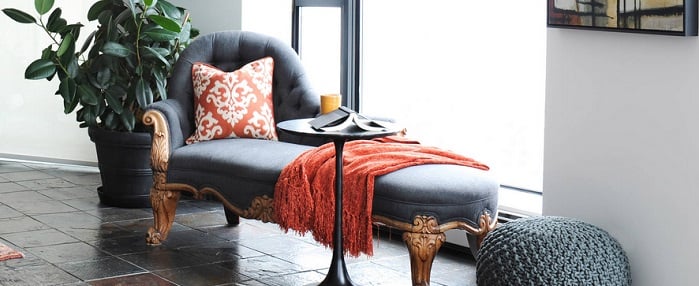Do you ever see a piece of furniture that you absolutely must have in your home? If it’s a bold, distinctive piece, it can be hard to make it work with the furniture you already have. Today, I’m here to help you build a unique furniture set that stays together. For an example, I’m going to focus on an exquisite chaise that’s been recently added to the Home Thangs catalog. It’s gorgeous enough to deserve the attention, but odd enough to be a challenge to integrate into a contemporary room.
Fell In Love With An Odd Accent Piece?
I am in love with this chaise. It is sleek and sophisticated while still feeling antique, a great combination of old and new style. Its size means it can work in most living rooms or bedrooms, but the style? Requires a little more care to make it stand out in a good way. Everyone’s homes are different, and what I think works may not for you, and vice versa. You could easily match this chaise to other furniture by the same brand. Then again, you wouldn’t be reading this blog post if you didn’t like experimenting with your furniture! So how do you start to stitch a unique and distinctive piece of furniture into your existing decor?
Don’t Pass It Up, DRESS It Up!

Accent pieces are meant to stand out from the rest of your furniture. But if the style is very different, that might not feel like a good thing. So the first step is to decide how prominently the piece will feature. Will it be part of your living room set or a standalone reading corner in your bedroom? Then, accentuate your accent accordingly. Wall art, linens, other small furniture, and knick knacks can help reframe your accent piece, either drawing attention to it or helping it blend into the surrounding furniture. A large painting, floor length mirror, or other wall art can redouble the impact of a bold accent; a collage of paintings with different frames can help unify furniture with different wood work, and well-chosen pieces can tie together different upholstery colors.
Put It In The Right Light

You can also use your lighting to similar effect. A big overhead light (or an arc-style floor lamp) that lights your whole furniture set evenly will serve to help – literally – cast an unusual piece of furniture in the same light as the rest of the room. Conversely, distinctive lighting – spotlights, close-sitting table or floor lamps, or niche lighting – can all help draw the eye. That’ll not only make the furniture stand out, but make its different-ness feel on purpose – a centerpiece rather than an oddball. For something like a chaise, lighting can also help instruct guests on how the piece should be used. A swing-arm lamp will invite readers; a nearby dimmer switch can help spell a binge-watch movie spot.
Accents For Your Accents

Really unusual accent pieces – whether it’s a chaise, chair, table, or cabinet – can sometimes be strange-looking enough that they can be difficult to parse visually. That’s a bad thing – you don’t want your home looking like a set piece! The good news is, humans are great at reading visual cues. A thoughtfully draped blanket can nix the confusion about how to sit on an asymmetrical antique chaise, for example. If you love a side table that has a sculptural, artsy feel? Put it next to a chair and leave a coaster on top so your guests know it’s a table. Good accent furniture can also be good camouflage. Paring an antique piece with something modern can help modulate the look, so it feels more transitional than eclectic.
Using Puzzling Pieces As Problem Solvers

A final piece of advice: if you see an oddball accent piece you love, instead of asking how much trouble it’ll be to integrate into your space, ask whether or not it might solve a problem with your space. Backless chaises have started to become a popular choice for an open greatroom. They’re an unconventional option, but are attractive and usable from either side. That means you get the functionality of more furniture without closing off your living room sitting area – a big problem with open floorplans. Other weird options, like tiered or nesting coffee tables, not only have visual flair, but can make a small space more usable.
In a design world dominated by samey-furniture, I always encourage people to take a chance on something different. So if you see something you love – whether it’s a chaise lounge, chandelier, or bar cart – don’t dismiss it as too weird. There are plenty of ways to turn the “volume” up or down on your decor, and that odd shape, style, or design might be just the thing that makes your house a home.
Shop our Chaise Lounges:


